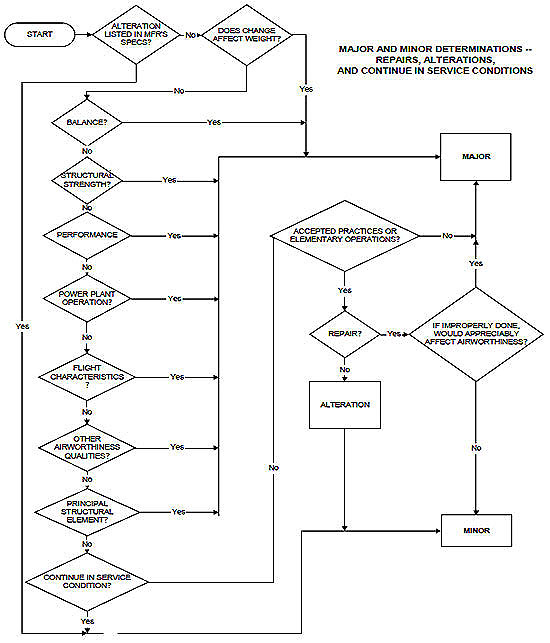
Meeting an aircraft’s type design or properly altered condition is one of the requirements to maintain the validity of a standard airworthiness certificate.
Properly altered condition means an alteration that is performed correctly in accordance with FAA approved data. The owner/operator of an aircraft must make sure that any alterations or modifications accomplished on the aircraft are accomplished in accordance with FAA-approved data.
The FAA defines a Major Alteration as an alteration not listed in the aircraft, aircraft engine, or propeller specifications—
(1) That might appreciably affect weight, balance, structural strength, performance, powerplant operation, flight characteristics, or other qualities affecting airworthiness; or
(2) That is not done according to accepted practices or cannot be done by elementary operations.
The FAA published an advisory circular AC 120-77 - Maintenance and Alteration Data. In that document is a decision chart that can be used to determine what is considered to be a major or minor alteration. That decision chart is shown below:

Supplemental Type Certificates (STC)
A supplemental type certificate is one form of FAA approved data that can be used to perform an aircraft alteration. The applicant must submit the engineering data used in the design of the alteration for review. Instructions for continued airworthiness and any flight manual supplements must also be submitted.
STC’s are reviewed and approved by the FAA Aircraft Certification Office (ACO) that serves the geographic area of the supplemental type certificate owner’s residence.
The STC and all referenced drawings, data, and specifications are the property of the supplemental type certificate holder, so the aircraft owner (installer) must have written permission from the owner of the STC before it can be installed.
If you vary from the instructions or the materials referenced in the STC, you must seek further FAA approval.
Supplemental Type Certificate Numbering System is as follows:
Certificate Number = SX NNNNN YY-D
S indicates a supplemental type certificate (blank if a type certificate)
X = An alpha digit to identify the type of product that it is:
A = Small AirplaneB = BalloonE = EngineG = GliderP = PropellerR = RotorcraftS = AirshipT = Transport Airplane
NNNNN = assigned number automatically generated by ACOS; for example, 00146.
YY = Two alpha digits to identify the issuing Aircraft Certification Office (ACO)
AC = ASW-150, Ft. Worth Airplane Certification Office
AK = ACE-115N, Anchorage Aircraft Certification Office
AT = ACE-115A, Atlanta Aircraft Certification Office
AT = ACE-115A, Atlanta Aircraft Certification Office
BO = ANE-150, Boston Aircraft Certification Office
CH = ACE-115C, Chicago Aircraft Certification Office
DE = ANM-100D, Denver Aircraft Certification Office
EN = ANE-140, Engine Certification Office, Boston
LA = ANM-100L, Los Angeles Aircraft Certification Office
MC = ACE-100M, Military Certification Office
NY = ANE-170, New York Aircraft Certification Office
RC = ASW-170, Ft. Worth Rotorcraft Certification Office
SE = ANM-100S, Seattle Aircraft Certification Office
SC = ASW-190, Ft. Worth Special Certification Office
WI = ACE-115W, Wichita Aircraft Certification Office
D = indicates Designated Alteration Station (DAS) issued STC (blank if not DAS issued)
As an example, SA00125AT would be an STC issued by the Atlanta ACO on a small airplane with the assigned number 00125.
Manufacturers Service Bulletins
The FAA relies on the manufacturer to recommend in-service improvements as necessary to improve the design or safety of a product. The manufacturer has internal quality procedures in place that are approved by the FAA. When these procedures are followed, the data they develop to perform the aircraft alteration is considered FAA Approved Data.
Other Data Approved by the FAA
Other data means the engineering data (design analysis) and installation instructions used to accomplish the aircraft alteration. This data is reviewed and approved by the FAA or an FAA Designee. They use FAA Form 8100-9 or FAA Form 8110-3 to approve the data. This does not approve the installation. The installation must be performed and approved by an authorized individual. The record entry required by FAR 43.9 must also be made.
FAA Field Approval of an Aircraft Alteration
A field approval is an approval by the FAA of technical data and/or installations used to accomplish a major aircraft alteration. Technical data so approved becomes technical data approved by the Administrator. This type of approval may be accomplished for one-time approval.
The FAA is moving away from this type of approval with the exception of light aircraft, and even then they shy away because of the potential liabilities.
Approvals from Other Countries
The FAA has a growing number of bilateral agreements with different countries. They are accepting repair and aircraft alteration data approved by a country with which the United States has a bilateral avation safety agreement (BASA) with implementation procedures for airworthiness (IPA), if those documents speak to the acceptance of that data.
Acceptance of these approvals is for aircraft alterations up to the level of an STC. If a foreign STC was issued for the alteration, it will need to be validated by the FAA before an aircraft could be certificated in the United States.
0 comments:
Post a Comment